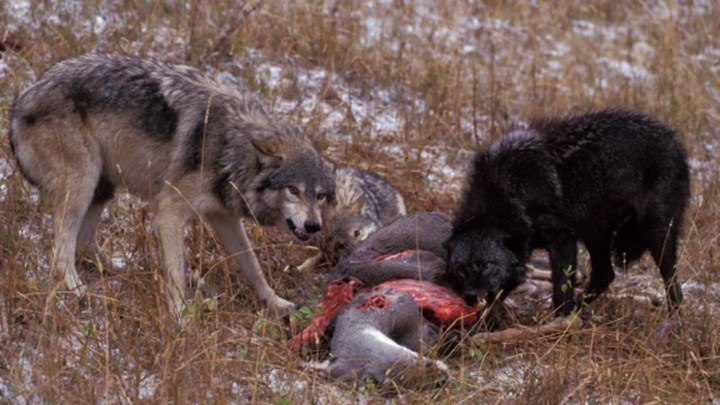
by Jim Zumbo - Sunday, April 9, 2017

When 31 Canadian wolves were introduced in Yellowstone Park in 1995 and 1996, and 35 were released in Idaho during the same time period, one of the biggest wildlife controversies in the West erupted. The wolves rapidly spread from their release sites and multiplied, much to the delight of wolf advocates. Stockmen and hunters, on the other hand, expressed concern.
From the beginning, wolves came under the protection of the Endangered Species Act (ESA) and were under the jurisdiction of the U.S. Fish and Wildlife Service (USFWS). As part of the Wolf Recovery Plan between the Feds and the states of Wyoming, Montana and Idaho, wolves would be delisted with jurisdiction being given to each state wildlife agency. The criteria for delisting required that wolves exceed a minimum number of animals and breeding pairs. It didn't take long for wolves to exceed the minimums, and despite litigation, the three states eventually were given the jurisdiction they sought, allowing them to establish wolf management plans where very limited hunting would be allowed. The Idaho and Montana recovery plans were accepted first, but Wyoming's plan stalled because of the state's proposal to establish two separate wolf hunts. One was a regulated hunt where wolves would be harvested according to a quota system within a broad area that took in millions of acres outside Yellowstone Park, and the other was a "predatory animal" zone covering the rest of the state. In the latter area, wolves could be hunted with no seasons, bag limits or licenses. Wyoming's rationale was to maintain acceptable numbers of wolves within the management area, and no tolerance for wolves outside it.
That plan was finally accepted in 2011, and Wyoming established limited hunts in 2012 and 2013. But several groups brought lawsuits challenging the delisting, and the National Rifle Association of America (NRA), Safari Club International (SCI) and the Rocky Mountain Elk Foundation (RMEF) intervened. Then in 2014, U.S. District Judge Amy Berman Jackson ruled that the Wyoming plan was insufficient and rejected it. Once again, Wyoming's jurisdiction was lost and wolves were protected under the ESA. But on Friday, Mar. 3, 2017, a three-judge panel of the U.S. Court of Appeals for the District of Columbia Circuit ruled that wolf management would once again come under the jurisdiction of Wyoming. Judge Judith Rogers, a Clinton appointee, wrote: "The record demonstrates that the Service (USFWS) reasonably and adequately responded to concerns about the reliabilities of Wyoming's management plan.” Judges Janice Rogers Brown, a George W. Bush appointee, and Cornelia Pillard, an Obama appointee, heard the case with Rogers.
As it stands now, several environmental groups have 45 days from the Mar. 3 ruling to file an appeal. Timothy Preso, lead attorney in the suit for Earth Justice, said, "We will continue to fight to protect wolves against extreme and hostile state management policies." John Malmberg, publisher of Wyoming’s Cody Enterprise, wrote: “Preso and others would have a modicum of credibility if they had waited for actual plans to be announced rather than fighting straw men and unannounced policies."
According to Renny MacKay, communications director for the Wyoming Game and Fish Department, "We don't have guidance yet on what it means in terms of wolf management." In all likelihood, the state is expected to implement once again the dual management strategy—the one inside the wolf management area and the other in the predator area.
As a resident of northwest Wyoming, where wolves are seen and heard outside my mountain home, I'm relieved that the state can hopefully continue to maintain some control of wolves, even though harvest quotas will be relatively low. There are multiple confirmed reports of wolves killing and eating dogs as well as livestock. To the concern of hunters, that doesn't take into consideration the impact on big-game animals, especially elk and moose. This decision was long awaited by those of us who could only sit by and watch wolves multiply with no control, and expand their populations throughout the state.
As explained on the USFWS’ own website, the ultimate goal of the ESA is to “recover” species that are listed so they no longer need protection under the ESA. Kudos to the state of Wyoming for sticking to its guns—in the form of science-based principles—and not backing down in the face of opposition. The state’s recovery plan accomplished what it was meant to do.
■ ■ ■
About the Author
Jim Zumbo is best known as a Western big-game hunter, though he has hunted deer in all 50 states and is an avid turkey, upland game and waterfowl hunter. With two degrees in forestry and wildlife, he has had more than 2,000 articles published in outdoor magazines, written 23 hunting books and conducted numerous hunting seminars nationwide, including for NRA Hunter Services. In addition to serving as a full-time writer/editor for Outdoor Life magazine for 30 years, most of them as hunting editor, he was host of the popular outdoor TV show “Jim Zumbo Outdoors.” A Benefactor member of the NRA, Zumbo has won numerous awards for his writing and remains active with conservation groups, including serving three terms on the Rocky Mountain Elk Foundation’s board of directors. For information on his biography, “Zumbo,” released in November 2016, click here.
E-mail your comments/questions about this site to:
[email protected]
